Over the years, I’ve had many readers ask for a good overview shot of the garden to get a sense of how everything is laid out.
I’ve attempted this a few times, but never felt that the pictures painted an accurate view, as the entire property sits on a steep hill and the yard is terraced the whole way down.
So, what better way to show the property than from a bird’s eye view?
I’m mildly obsessed with researching coastlines/campgrounds/trails/neighborhoods on Google Earth so naturally, I pulled up an aerial satellite shot of my property to map out the garden.
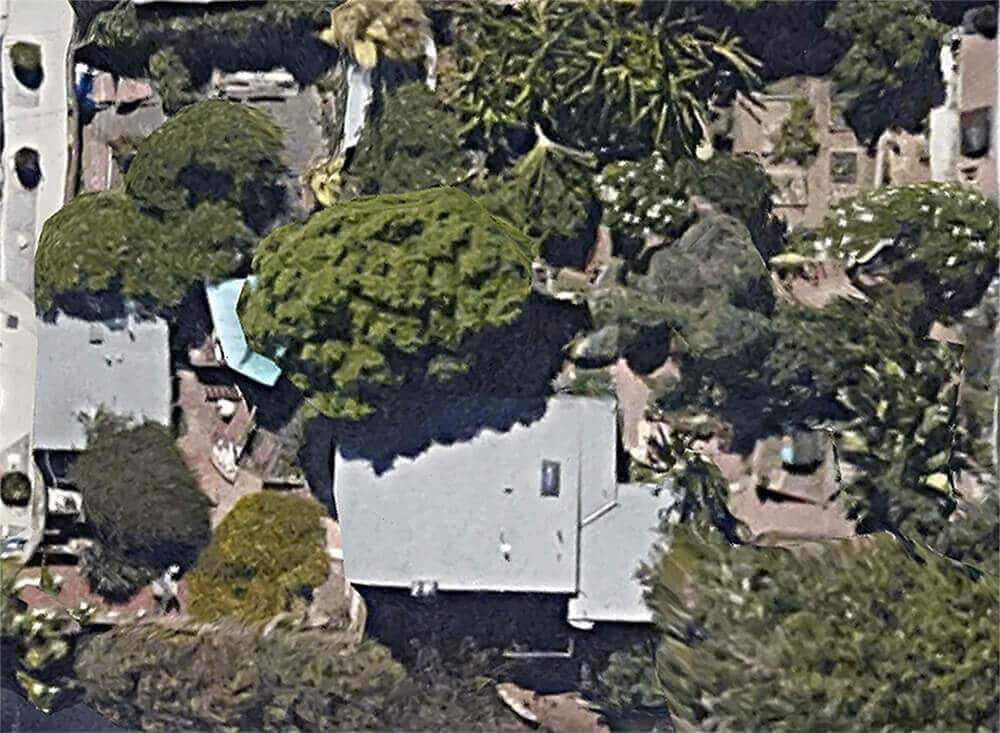
Though my hardiness zone is 10b, I’m in a coastal microclimate in the South Bay that’s usually 10 to 15 degrees cooler than the rest of Los Angeles. Throughout the year but mostly in summer, a marine layer moves in on the peninsula, either in the early morning or late afternoon. It gives us those wonderful ocean breezes but also makes it challenging to grow squash (due to powdery mildew) and alliums (due to rust).
On top of that, we have very heavy clay soil that sometimes feels like we need a jackhammer to transplant seedlings. It’s one of the (rather amusing) reasons our carrots take on many shapes and sizes as they push their way through the soil.
Despite these small setbacks, I’m grateful that I learned how to garden in a climate that’s so forgiving. We can start seeds outside all year long, tend to perennial pepper plants, and harvest tomatoes into winter. A lot of people are surprised when they hear I only started gardening in 2010. I credit this property and our temperate weather for giving me ample opportunity to grow, nurture, kill, and experiment with thousands of varieties of plants in the time I’ve lived here.
As you’ll see below, what might seem confusing from the map is that I don’t have a front yard; the whole property is fenced and the front “yard” is just a walkway from the street. I love this setup since it means we can take advantage of all that land without having space wasted on driveways and such. Stepping into the yard feels like you’re stepping into an urban farm (or farmlette, as I like to call it, or eclectic jungle, as you may be thinking) rather than a traditional backyard.
That said, only half the lot (about an eighth of an acre) is actually usable growing space, as the other half is the main house, the guest house, and various paths and stairs. The main house is a charming little bungalow built in the late 1920s. It had been added onto over the years, but still retains a lot of the quirks of the original era.
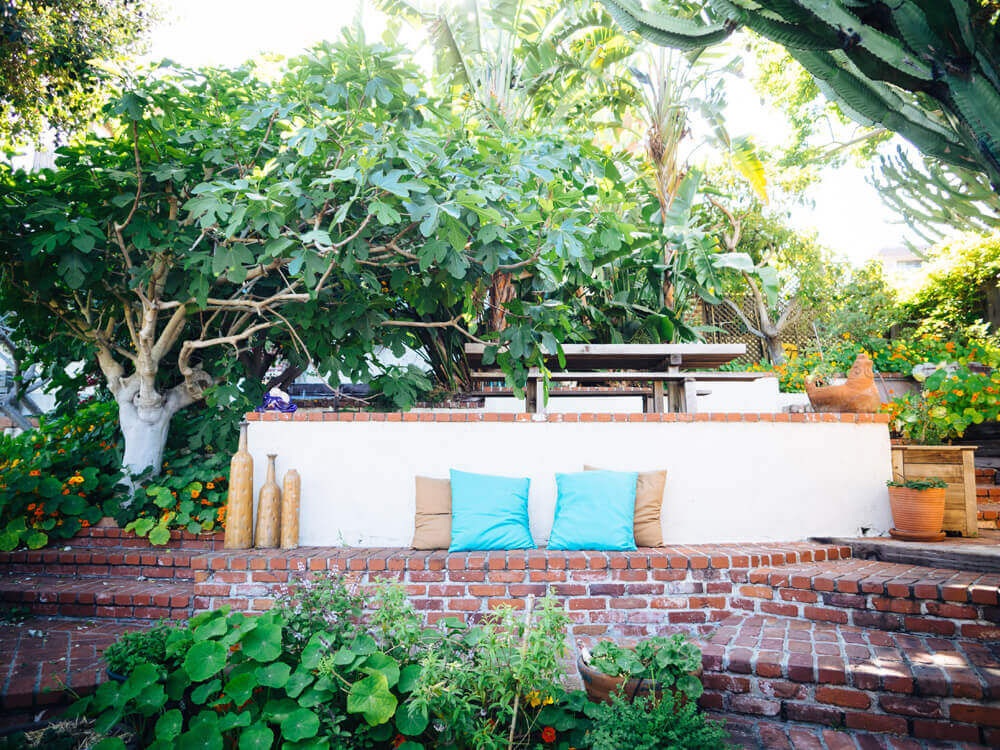
We’re currently renting the property from a family who had first purchased the house in the ’70s. Back then, it was a single 5,000-square-foot lot, a size typical of the neighborhood. At some point, the person who owned the adjacent empty lot decided to sell, so our landlords snapped it up.
They never built on the second lot, instead turning it into a green sanctuary full of fruit trees, raised beds, and terraced gardens. They raised all their children here and continued to live as empty nesters until the early 2000s. Long story short, they sold the house, then bought it back at the bottom of the real estate market in 2009, as they couldn’t bear the thought of an investor razing the house to build an apartment building.
We moved in a year later — to a rustic oceanview property on a double lot (a rare find for Los Angeles) with a thriving garden already in place. We’ve added our own decorative touches over the years as well as new garden beds and plantings, but have otherwise left the property as is. The woodwork, brick paving, and Spanish tiling were all here when we arrived.
We were (are) very fortunate to have made our lives here for so long, and this garden will always be remembered for being the birthplace of Garden Betty.
Below, I’ve marked up the map with how each component of the farmlette fits within our quarter-acre lot. For a continually updated list of specific varieties we grow each season, click here.
And stay tuned, as you’ll be seeing much more next week when I post a full video tour of the garden!
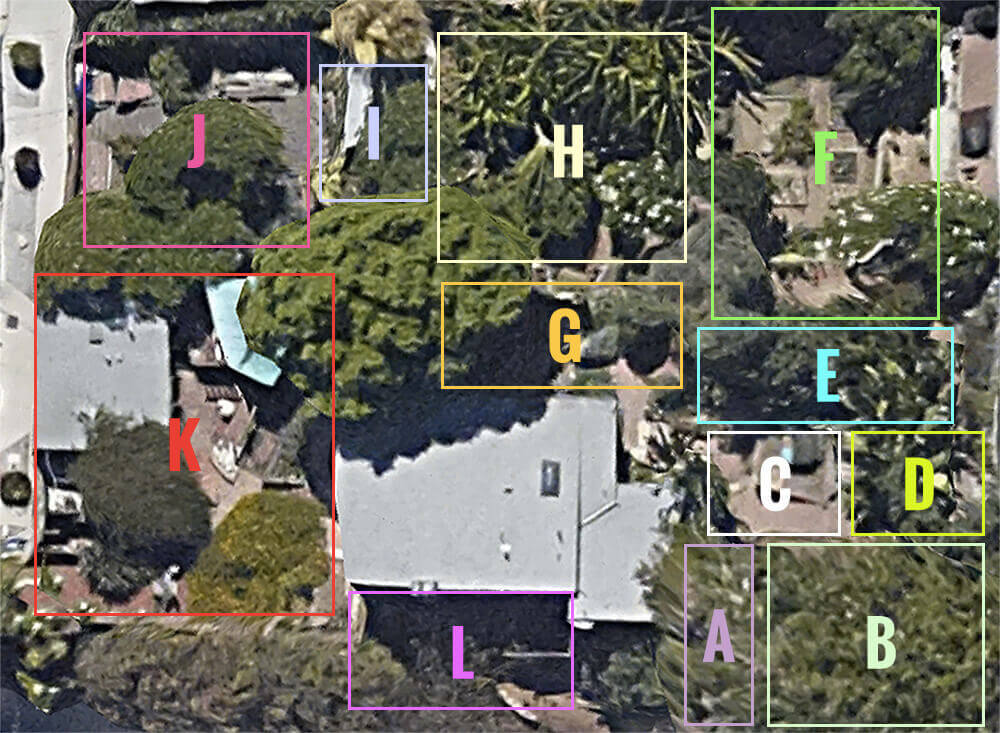
A. Entryway
Walking into our yard near the top of the hill, you’re greeted by a row of perennial African Blue basil that stays in bloom year-round, and in the spring, paperwhites to the right and pink jasmine to the left. This is one of my favorite nooks in the whole yard — it’s an olfactory sanctuary!
The tree towering above the entryway and shading most of our front yard is a two-story-tall floss silk tree.
B. Flowers and Fruits
We have a 100-square-foot plot that’s filled with volunteer nasturtiums from late winter to late spring. On the terrace above are four blueberry bushes (including my favorite, pink blueberries) and a stately avocado tree that we estimate to be at least 30 to 40 years old. We don’t know what variety it is, but the fruits it bears are huge (close to a pound each).
C. Herb Garden and Patio Plants
Since this area is right outside our kitchen door, we reserve it for herbs and other plants we pick most often or need to keep a close eye on, such as strawberries. Most of the patio plants are various mints we grow, along with an Australian finger lime tree.
On the wall against the house (hidden under the tree in the aerial map), we have a succulent garden and a vermicompost bin (which we’re phasing out in favor of just walking our kitchen scraps down to the compost tumbler once or twice a week).
D. Entertaining Deck
We built a large redwood dining set right after we moved in, and it’s been the center of countless alfresco meals and house parties over the years.
Behind the deck is a row of 12-foot-tall birds-of-paradise and behind that, a perennial patch of bulb fennel that we keep away from the herb and vegetable gardens due to their allelopathic reputation.
E. Mini Orchard
The owners have told us that at one time, our property was a fig orchard. As the neighborhood developed, the orchard was removed save for a single fig tree that still stands on our lot, some 50-plus years later. We’ve never figured out what type of fig it is, but it produces a wildly prolific harvest of sweet, purple-tinged figs every summer, and even a few handfuls in winter.
There’s also a mulberry tree, feijoa tree, and orange tree here, all of them at least 20 years old.
F. Vegetable Garden
Most of our raised beds, edible flowers, and compost heaps are found here on three levels. We have a mix of annual and perennial plants, along with a grapefruit tree (probably 30-plus years old). Along the back wall are a potting bench, a few small sheds and shelving units filled with pots, trays, fertilizers, and other gardening supplies, and a wood-fired barbecue and smoker.
New to the lower level is a small coop (actually a rabbit hutch) that we previously used to quarantine our new chickens. Now that the flocks are integrated, we’re keeping the coop in place as a “recovery coop” in case we need to separate a hen for health or safety reasons.
G. Courtyard with Container Citrus
I love this intimate little area. It’s where we end most evenings after our dinner parties, sitting around a fire pit and winding down over glasses of wine. Our container citrus trees are down here (including the blood orange that I planted my placenta under) along with more herbs that grow above or trail down the rock walls.
H. Chicken Coop and Banana Grove
All the trees along the perimeter fence are bananas, and at any given time, we have half a dozen fruiting stalks (out of a couple dozen mature stalks). We also have lemongrass, a couple more vegetable beds, and another composting area with a tumbler and a leaf/straw litter pile.
One level down from the banana grove, and gated off from the rest of the edible garden, is the chicken coop and the weedy pasture where our flock free-ranges all day.
I. Greenhouse
This structure was here when we moved in, but since Southern California weather is fairly warm year-round, we’ve never used it for its intended purpose. The greenhouse is more of a storage shed that holds our gardening supplies and equipment.
J. No Man’s Land and Volunteer Tomato Patch
For the first few years, this lower yard served as our holding area for firewood and leftover lumber from house projects. (We also created some of the shooting surfaces for The CSA Cookbook down here.) The chickens loved the vast expanse of dirt for their daily dust baths, and the volunteer tomato plants loved the space so much that their vines would sprawl over 10 feet long on the ground.
It was also where old furniture went to die until we realized we couldn’t keep piling up the junk (and a new fence being built forced us to finally tidy up the space). We have a lemon tree down here, as well as a new round of volunteer tomatoes this season, but we mostly let the weeds and wildflowers take over for the chickens to forage.
K. Guest House, Hot Tub, and More Fruits and Flowers
Gardening-wise, we don’t spend too much time in this part of the yard at the bottom of the hill. There’s a pomegranate tree and another orange tree, but we otherwise keep it pretty low-key (and drought tolerant) with a couple of ornamental beds that include lantana and Mexican bush sage.
Wood sorrel grows abundantly in these beds in spring and we weed them to feed to the chickens.
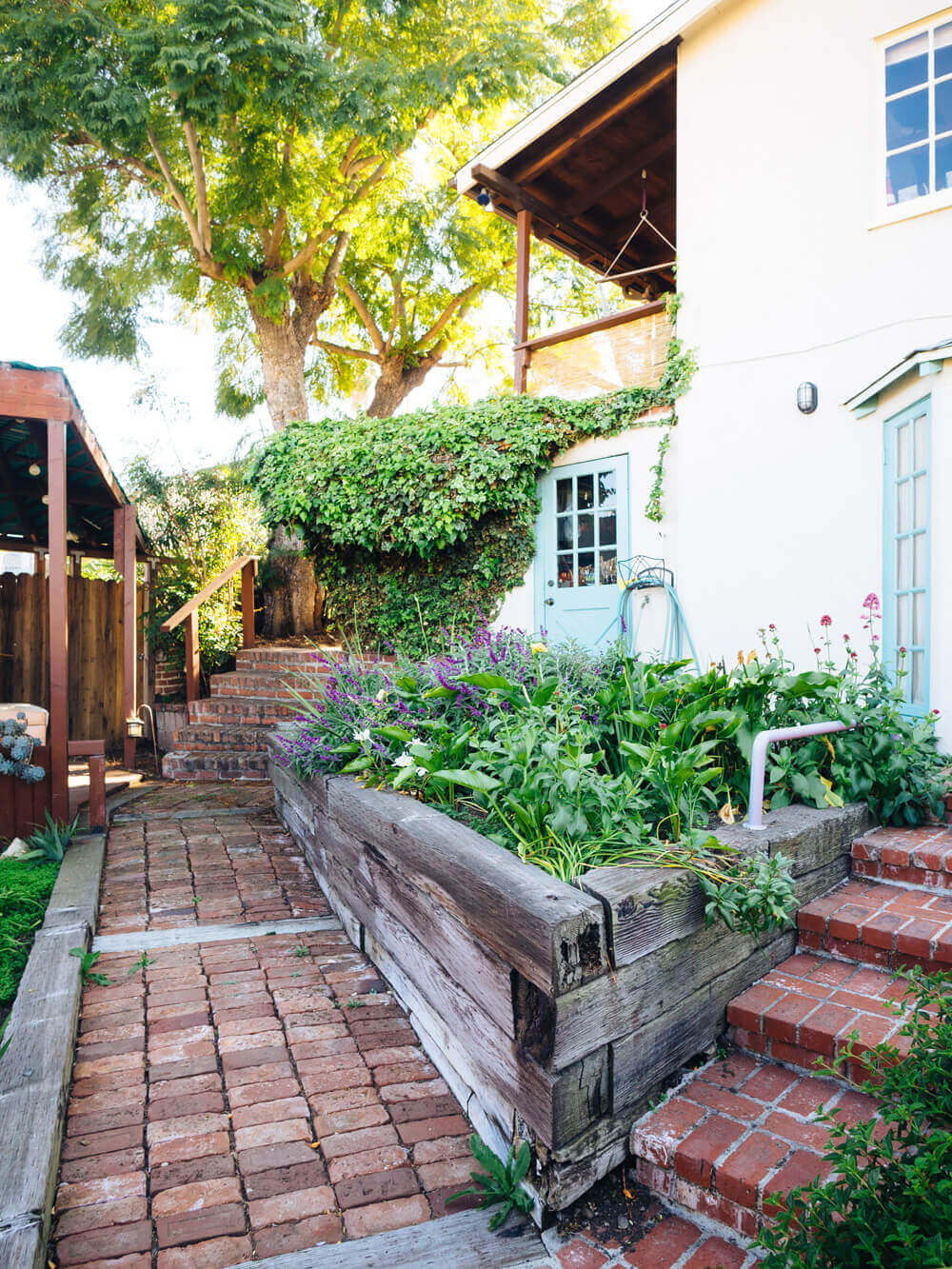
L. Nasturtium Patch
Our home office looks out into this side yard, and in spring it’s bursting at the seams with nasturtiums. It’s beautiful! I wish they would bloom all year, but since we don’t supplement the rain with irrigation, they start to fade by late spring. The rest of the year, the side yard is very simply landscaped with succulents.
On the other side of the fence (technically our front yard), we have a young apple tree that was probably planted right before we moved in. It sits in shade for most of the day, so it only produces a dozen to two dozen apples per season and the birds usually get to them before we do. I’m okay with this, especially if it keeps them well fed and away from our other fruit trees!



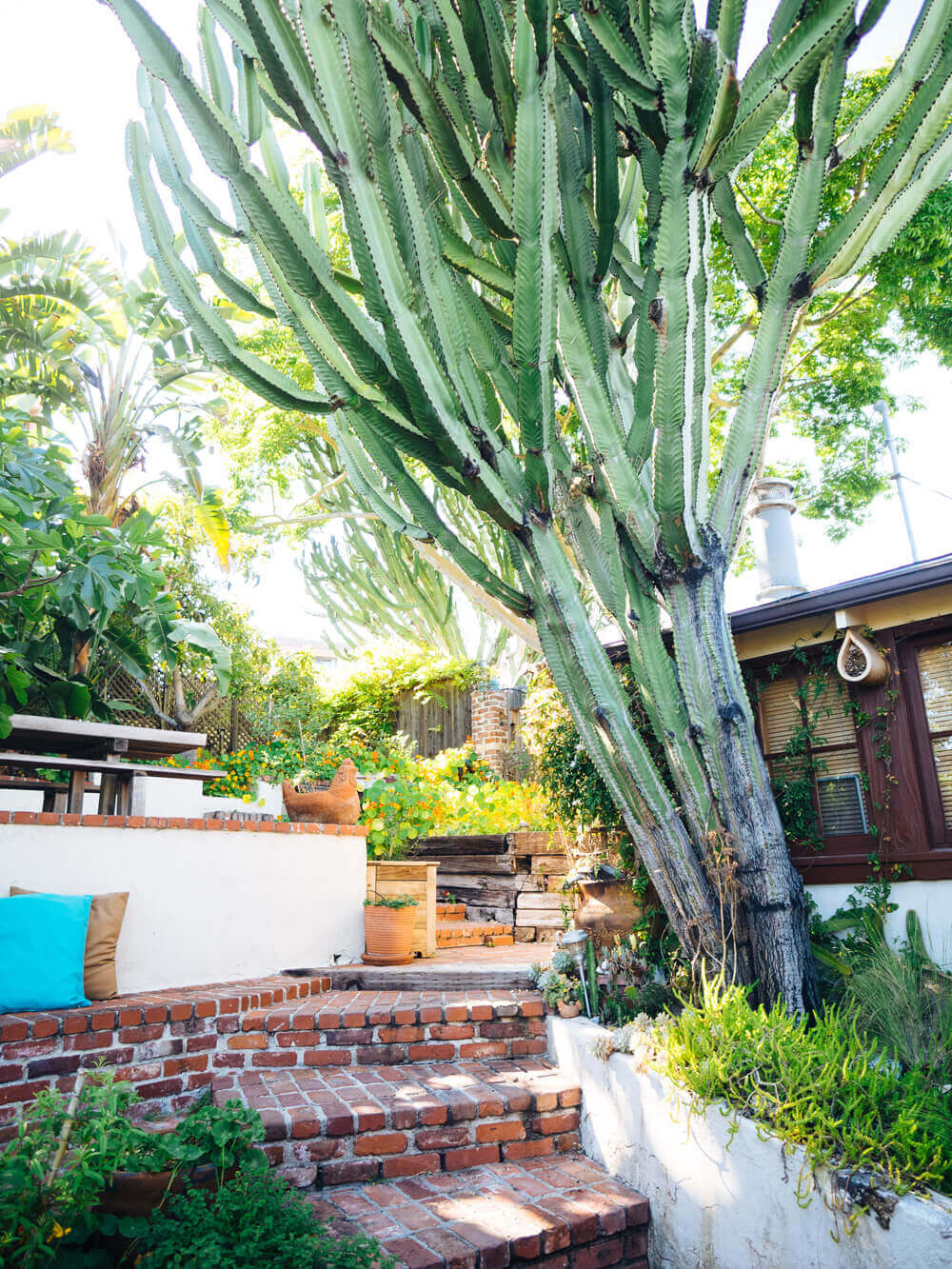













Wait this is absolutely amazing! I’m a reader who found your blog through a Google search just now (about Fava beans). My jaw dropped when I read that you are located in the South Bay since that means you are so close to me.
I am working steadily on my parents’ backyard garden in Redondo Beach. Heck I might even be in your neighborhood! You have such a beautiful garden. I would love to connect if that’s possible.
Hi Brianna! Gardening in the South Bay is such a blessing… it has its challenges, for sure, but the year-round mild weather means lots of opportunities for growing. 🙂 I only know this because I’ve actually just moved to Bend, Oregon, after 15 years of living in the LA area! 🙂 Good luck with your parents’ backyard!
Fun!!! I grew up in a previous fig orchard also in Montebello! As a portion of the land was subdivided, the lovely Italian couple that owned it, left a fig tree in each lot. Soooo cool! Ours had a black and a white fig grafted on. Amazing. Now I’m going to try growing them in our new home in coastal Rhode Island. Very excited to use expertise from local Westerly, RI friend whose folks grew figs there by cutting roots on one side of tree, laying tree down!, and mulching the tree for winter! Doesn’t that sound exciting? I’m desperate for my homeland figs and can’t wait! 🙂 Thanks so much for the tour. Exciting!!!
A grafted fig tree sounds very neat! As does introducing a new tree to your new home. Good luck!
Thank you for your posts…you are a true inspiration!!!
You’re welcome, I’m so happy you enjoy them!
PLEASE tell me that you’ll buy this property some day! The idea of it NOT being a garden is… upsetting! And I’m just an online fan girl! I can’t imagine a different tenant letting your hard work go to waste.
We’d considered it when we first moved here, but as our family has grown and our goals have changed, we’ll eventually have to move on. We hope the next person appreciates the house and garden just as much as we have!
Love this!
That’s gorgeous! The nasturtium patch is amazing! Now you are giving me ideas for mapping my own yard. Can’t wait for the video!